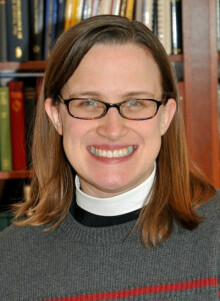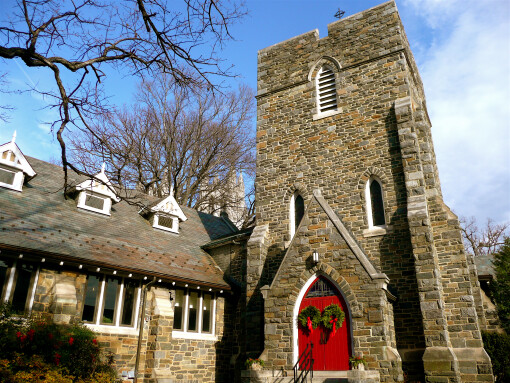Such a Time as This

Series: Pentecost
Speaker: The Rev'd Emily Griffin
Once upon a time, in a kingdom far, far away, there lived a woman who spoke truth to power and was believed. She didn’t need to hide her beauty or her femininity or her emotions to be heard, and she could take credit for what she accomplished. Her name was Esther. I loved this story as a child. I warn you - this is my only shot to preach about her in a 3 or maybe even 6-year lectionary cycle, so I’m going to take it. Don’t worry – the Gospel doesn’t need to be named directly to be present and active, but more on that later.
We get a glimpse of Esther’s story in today’s first reading. I remember hearing it for the first time with my 2nd Grade Sunday School class. We didn’t catch the subtleties, of course. We thought she got to be Queen by winning a beauty contest; the whole “forced to join a harem” thing went way over our heads. Probably for the best. We didn’t pick up on the exaggerated numbers either. Did Haman really build gallows that were six stories high? Picture that for a second. We didn’t notice the absurdities, the elements of farce. Nor did we notice that God wasn’t mentioned in the story, not even once. We just assumed God was there. God didn’t need to be named to be present. God’s hiddenness didn’t bother us yet. We were used to playing hide and seek; just because we couldn’t find someone didn’t mean they weren’t there.
There’s a lot of hiddenness in the book of Esther. Esther hides her Jewish identity at first. We’re not told why, other than that her cousin Mordecai told her to. It was easier than you might think. You see, she and Mordecai were part of the Diaspora – the descendants of those forced out of Judah at the exile. We find them in Persia, or modern-day Iran, after the Persians have conquered the Babylonians and are now the world’s great superpower. A few generations have passed. These are Jews who’ve never seen Jerusalem, much less the Temple. No one is keeping track whether or not they keep the Sabbath. Their dress, their diet, their schedules, their marriages don’t seem to be much different from the culture around them. In that respect, their secularized world isn’t so different from ours. With nothing obvious and visible to mark them as people of faith, their actions need to speak for themselves.
Before we get to the drama of today’s reading, we need to rewind a bit. We’ve already heard about Esther and her beauty, her cousin Mordecai, the king. The other main character here is Haman. Haman is the king’s chief of staff. He gets so riled at Mordecai’s refusal to bow to him as he passes that he plots to get rid not just of Mordecai but of all the Jews in the land. He turns his personal resentment into public policy. He convinces an easily duped king that this ethnic minority isn’t assimilating fast enough; they’re not obeying the laws of the land; they’re enemies of the state and need to be eliminated. He throws in a bribe, and the king is convinced.
When Mordecai gets wind of this planned genocide, he begs Esther to intercede with the king on behalf of their people. When she reminds him that she could be put to death for even approaching the king uninvited, Mordecai replies: “If you keep silence at such a time as this, relief and deliverance will rise for the Jews from another quarter, but you and your father’s family will perish. Who knows? Perhaps you have come to royal dignity for such a time as this.” After fasting for a few days, she comes up with a plan. She times her moment well. She turns the tables on Haman, and she, Mordecai and all her people are spared.
In the biblical text at least, it’s this story that forms the basis for the feast of Purim. Then as now, Jews were to mark the anniversary of their deliverance each year with “days of feasting and gladness,” sending food to one another and presents to the poor. That all sounds lovely, even recognizably pious, but go to a modern Purim play – the piety of it all might remain hidden. It is by far the most raucous of all Jewish feasts. People come dressed up as various characters. Kids act it out as a play. The audience rings loud noisemakers to drown out Haman’s name every time he’s mentioned. To me, it sounds a bit more like Rocky Horror Picture Show than church. But maybe that’s not such a bad thing. There’s actual rabbinic instruction in the Talmud that you’re required to drink so much at Purim that by the end, you can no longer tell the difference between “cursed be Haman” and “blessed be Mordecai.” Ponder that kind of piety for a minute.
In researching for this sermon, I found a fascinating reaction to this practice by Elizabeth Cady Stanton – one of our country’s pioneers for women’s rights. (I somehow found 19th century feminist literature therapeutic this week.) Anyway, she wrote an entire commentary on Scripture called the Woman’s Bible. It’s sharp and snarky in exactly the places you’d expect. When it comes to her treatment of modern-day Purim, she reacts mostly as the stern temperance advocate she was. But even she recognizes the potential value of drinking what she calls “the wine of good fellowship until all feelings of vengeance, hatred and malice are banished from the human soul.”
I’m not sure drinking is required to appreciate this story, though. There’s wisdom in some of its hiddenness. Many scholars these days would shelve the book of Esther as Jewish Scriptures do - alongside other wisdom literature, like Job and Ecclesiastes – rather than with history as we do in our Protestant Bibles. When we’re freed up to consider what it’s trying to teach us rather than what “really” happened, we can see the story as satire – among other things. Aristophanes once called satire a vision of the “world remade” – and this vision where our hero’s beauty and femininity are sources of strength and can be made visible, where bravery is rewarded and treachery is exposed, where thoughtful deliberation and courage actually win the day – that vision gives us something to work for – and in a way that doesn’t let take ourselves too seriously as we do it.
But what about God’s hiddenness in this story? Where’s the Gospel in that? A few things to remember. First, hiddenness is not the same thing is absence. Nor is silence, for that matter. God’s silence in some situations is what gives us the room and the imperative to speak. Besides, the mere naming of God is no guarantee of divine presence. We can claim that God is on our side all we want, but personally I find that too much God-talk obscures and insults the One I’m looking for. The real work of faith happens when we don’t have an omniscient narrator or divine voiceover leading the way. Our world looks more like Esther’s than we like to admit. Our culture doesn’t teach us the language of our faith any more than Esther’s did; it’s part of why we’re here, to learn stories like Esther’s that give us the courage we need to live out our faith in the only arena in which it really matters – in our actions. In the silence that follows, I invite you to consider where God’s silence may be inviting you to speak, where God’s hiddenness is inviting you to make yourself visible, to live your faith out loud. In the Name of the One whose presence and grace transcend our naming, Amen.
 Welcome to St. Alban’s Church! Every Sunday, and most days in between, people gather in this place to worship, to learn, to grow, to share the joys and struggles of our lives, and to seek God’s grace in the midst of our lives. We do not come because we have it all figured out, but because we are seeking light on the way. We come as we are and welcome one another.
Welcome to St. Alban’s Church! Every Sunday, and most days in between, people gather in this place to worship, to learn, to grow, to share the joys and struggles of our lives, and to seek God’s grace in the midst of our lives. We do not come because we have it all figured out, but because we are seeking light on the way. We come as we are and welcome one another.

